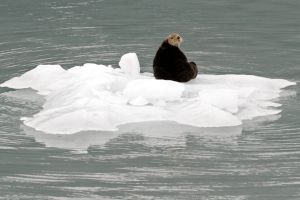1)
I think it was a pleasant visit! At first, I was very nervous, I was afraid that I would not communicate with the fourth-grade students, or they would not like me. But gradually I found out that they were friendly and the ideas were childlike. They would listen to my advice, and I would help them find some photos and texts in magazines and newspapers. My final project has not yet been determined, but in the process of making the collage, they also provided me with some new ideas. I was very impressed by the little girl sitting next to me. She didn’t find a lot of useful photos at first, but then we discussed it together to finish her collage, and this experience made me feel very happy.
2)
https://www.nytimes.com/2019/11/09/science/seals-distemper.html
– What attracted me was a photo of a sea otter sitting on a small piece of ice. This photo is very powerful to me because it looks ordinary, but it reflects a huge problem. Also, the helpless look in the sea otter’s eyes touched me. The problem can include the melting of ice water in the Arctic, and the mammals mentioned in the article that infect the Pacific Ocean.
– Ten years later, the planet may face the demise of marine animals and the loss of habitat. The reduction in Arctic sea ice caused by climate change may cause pathogens that infect marine mammals to spread more frequently between the North Atlantic and the North Pacific. Environmental changes such as sea ice ablation will not only change the behavior of animals, cause their death, but also open up new waterways, allowing different populations to come into contact, leading to the spread of the virus.
– This has a significant impact on our lives. Animal health, human health, and environmental health are closely linked. If one of the health deteriorates, then other elements will also deteriorate. This virus also affects humans that depend on animals. If seals and fish migrate farther offshore, fishers will find it harder to hunt and sustain their livelihoods.
– My final project may be about recycle and reuse. Now we face the dual challenge of energy supply and environmental protection. In the process of making clothes, it consumes a lot of resources and energy and also emits toxic gases to cause climate change and the environment. Abandon the idea of mass production, consumption, and waste. We can use the method of recycling, transform, and reuse to cope with climate change.
3)
– I want to implement a long-life practice to create an institution or company that recycles and re-sue old clothes.
– In the next decade, the company will focus on recycling old clothes and then using their ideas to create them twice to realize the value of these old clothes. As a fashion design student, I can use my knowledge of clothes and the practice I have learned to design and produce items that I like and satisfy based on each piece of old clothes, and then use this item or donated to those in need.
– As I said, clothing is a big industry. Many people throw away clothes because of the “trend” as time passes, many good clothes became “garbage.” So there are a lot of discarded clothes every year. Over the next ten years, it is hard to make the fast fashion industry disappear, even reduce the number of second-hand clothes. This practice is mainly through the recycling of all kinds of new and old clothes, professional transformation and processing, recycling and reuse of old and new clothes, and finally, donate or sell. At the same time, we regularly organize some charitable activities to carry out donations and publicity activities, and advocate the concept of “saving, energy-saving, and green.” At the same time, as recycling new and old clothes, we will pay attention to energy conservation and make real action. As many people care about this situation, more people would like to joy this practice. Let the public find pleasure in the process of recycling old and new clothes.
– This practice has a significant impact on the environment, climate, energy, and materials. The second-hand clothing industry’s environment benefits range from fewer carbon emissions to saving water and reducing waste. When it comes to energy conservation and emission reduction, people often think of the management of some energy-intensive and highly polluting industries such as electricity, steel, non-ferrous metals, building materials, and petrochemicals. By buying a simple and easy change such as unnecessary clothes, you can reduce energy consumption and make a significant contribution to energy conservation and emission reduction. According to calculations, under the premise of ensuring the needs of life, each person buys less than one worthless piece of clothing per year, which can save about 2.5 kilograms of standard coal and correspondingly reduce carbon dioxide by 6.4 kilograms. If 25 million people in the country do this every year, they can save about 62,500 tons of standard coal and reduce carbon dioxide emissions by 160,000 tons. In the actual process of producing clothes, a large amount of energy and resources are consumed, resulting in the emission of greenhouse gases and other toxic gases, which in turn cause climate change and environmental pollution. The important component of some low-end clothes is chemical fiber, and chemical fiber is a kind of non-reusable resource. If you throw away old and new clothes at will, it will inevitably lead to environmental damage.
– This practice meets these design criteria for design, environment, cost, function, manufacturing, repair, and safety. Doing the best possible to design practical and beautiful things. The clothes that used as the primary “material” to create these things have the concept of protecting the environment and reducing expenditure. Re-production and use are also “repair” in the sense that they can be reused.
